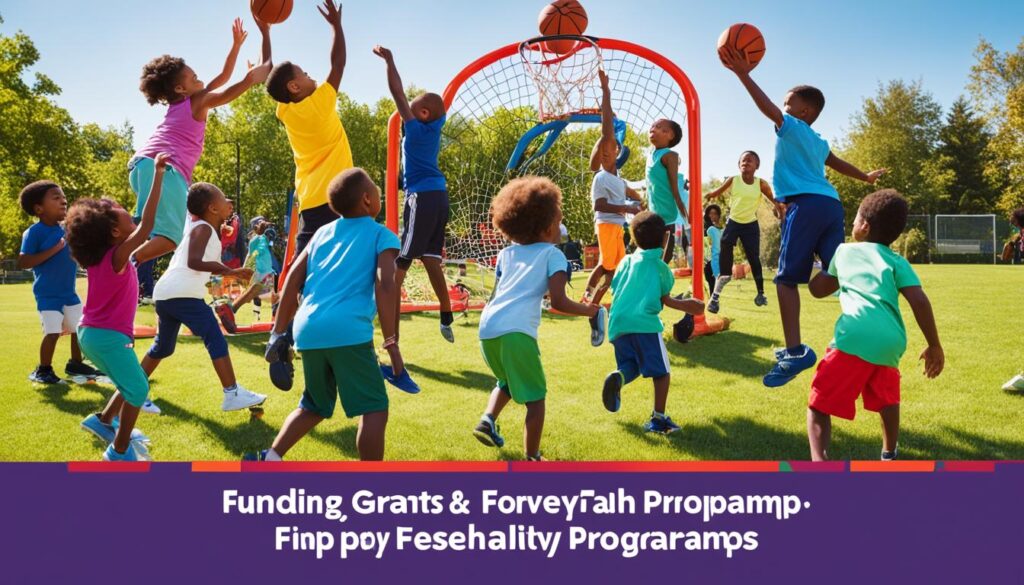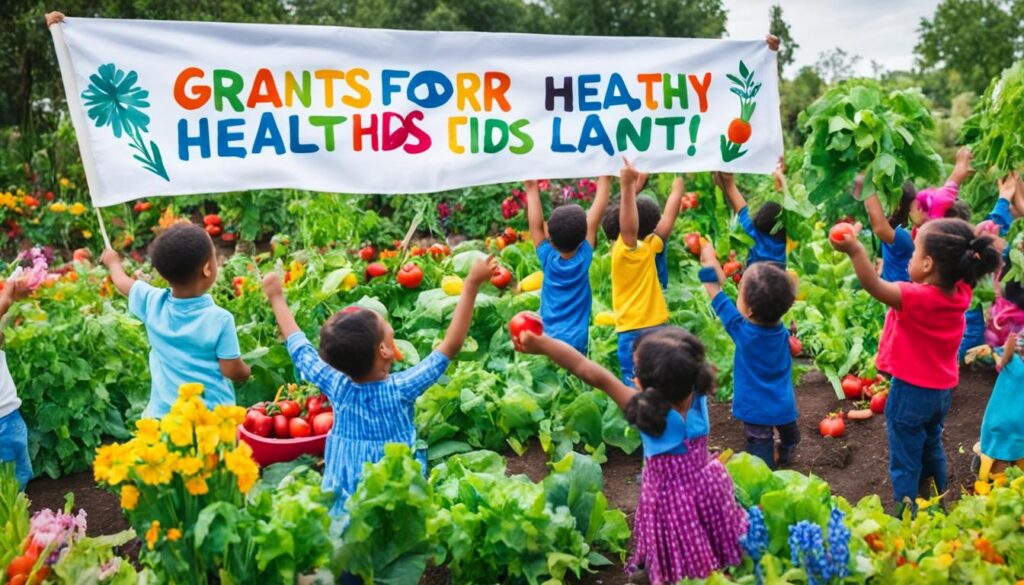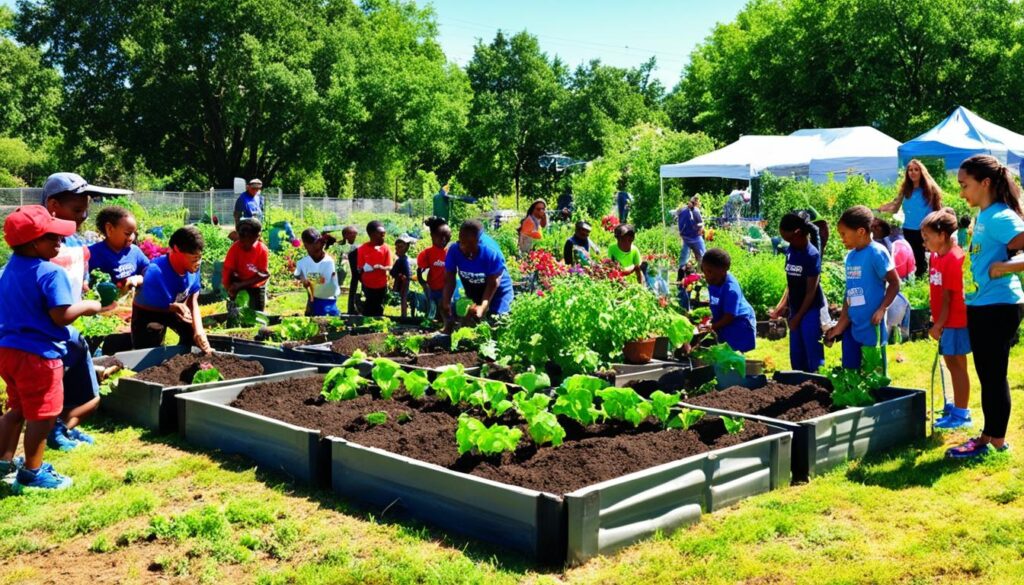Welcome to the first section of our article, where we will explore funding grants available for childhood obesity prevention programs (see my post here). As the prevalence of childhood obesity continues to rise, it is crucial to dedicate resources to initiatives that promote healthier lifestyles and combat this concerning trend. In this section, we will discuss various grant programs provided by reputable organizations such as the Centers for Disease Control and Prevention (CDC) and the United States Department of Agriculture (USDA).
Key Takeaways:
- Grants are available to support childhood obesity prevention initiatives.
- CDC offers funding, training, and technical assistance for programs in Early Care and Education (ECE) settings.
- The State Physical Activity and Nutrition Program supports statewide strategies for improving nutrition and physical activity.
- The Healthy Kids, Healthy Future Program focuses on enhancing ECE environments and practices.
- Other funding opportunities are available through organizations like USDA and NIH.
State Physical Activity and Nutrition Program
The State Physical Activity and Nutrition Program is a CDC-funded initiative that supports 16 statewide programs dedicated to improving nutrition and physical activity. These programs prioritize evidence-based strategies to combat childhood obesity and promote healthy lifestyles among children.
“Childhood obesity is a pressing issue that demands immediate attention. Through the State Physical Activity and Nutrition Program, we can implement effective interventions to prevent obesity and improve the overall health of our children.”
These statewide programs are instrumental in integrating nutrition and physical activity standards into early care and education (ECE) systems across the country. By incorporating such standards into ECE curricula, schools can ensure that children are exposed to healthy eating habits and regular physical exercise from an early age (check out my post on healthy eating habits here).
The State Physical Activity and Nutrition Program focuses on evidence-based strategies that have been proven effective in combating childhood obesity. These strategies encompass a range of initiatives, including:
- Promoting nutrition education
- Providing healthy meal options
- Encouraging physical activity
- Increasing access to fresh produce
- Training teachers and caregivers on best practices
By implementing these strategies, the program aims to create a supportive environment in which children can develop healthy habits that will last a lifetime.
Program Goals and Objectives
The State Physical Activity and Nutrition Program has the following goals and objectives:
- Reduce childhood obesity rates by implementing evidence-based strategies.
- Integrate nutrition and physical activity standards into statewide ECE systems.
- Provide training and resources to ECE providers to promote healthy behaviors.
- Enhance collaboration among stakeholders, including schools, parents, and community organizations.
The State Physical Activity and Nutrition Program plays a critical role in preventing childhood obesity and promoting healthy lifestyles among children. By funding and supporting statewide initiatives, the program ensures that consistent efforts are made to improve nutrition and physical activity within early care and education settings.
Healthy Kids, Healthy Future Technical Assistance Program

The Healthy Kids, Healthy Future Technical Assistance Program is a collaborative initiative between the Centers for Disease Control and Prevention (CDC) and the Nemours Foundation. Through this program, states are provided with grants to enhance nutrition and physical activity in existing state Early Care and Education (ECE) systems. The main objective of the program is to promote healthier environments and practices in ECE facilities, thus contributing to the prevention of childhood obesity.
To achieve its goals, the Healthy Kids, Healthy Future Technical Assistance Program focuses on implementing the CDC's ECE Spectrum of Opportunities. This framework outlines evidence-based strategies and recommendations to embed nutrition and physical activity standards in ECE settings. By utilizing this approach, the program aims to create a comprehensive and impactful approach to promoting childhood health and wellness.
Program Objectives:
- Improve the nutritional quality of food and beverages provided in ECE settings
- Increase opportunities for physical activity among children in ECE facilities
- Enhance the knowledge and skills of ECE providers in promoting healthy behaviors among children
- Foster partnerships and collaborations between ECE facilities, families, and communities
The Healthy Kids, Healthy Future Technical Assistance Program envisions a future where all children have access to environments that support their healthy development and well-being. By providing grants for youth obesity prevention programs, this program plays a crucial role in funding and supporting childhood health initiatives across the United States.
| Program Outcomes | Examples |
|---|---|
| Improved nutrition standards | Implementation of healthier menu options, increased availability of fresh fruits and vegetables, reduced sugary beverage consumption |
| Incorporation of physical activity | Structured playtime, outdoor activities, movement breaks integrated into daily routines |
| Enhanced staff training | Education on nutrition, physical activity guidelines, and best practices in promoting healthy behaviors |
| Engagement with families and communities | Workshops and resources for parents, involvement of community organizations in promoting health and wellness |
Obesity Mini-Collaborative Improvement and Innovation Network
In the Obesity Mini-Collaborative Improvement and Innovation Network, the Centers for Disease Control and Prevention (CDC) and the Association of State and Public Health Nutritionists work together to combat childhood obesity. Through this partnership, funding is provided to five states to enhance nutrition environments, policies, and practices in Early Care and Education (ECE) settings. The program adopts a comprehensive farm-to-ECE approach with the aim of creating healthier food environments for children.
The Obesity Mini-Collaborative Improvement and Innovation Network focuses on improving the nutrition landscape in ECE settings, ensuring that children have access to nutritious food and developing healthy eating habits. By funding initiatives that prioritize healthy food options and practices, this program plays a vital role in childhood obesity prevention.
The initiative recognizes that early childhood is a critical period for establishing healthy behaviors and preventing the onset of obesity. By implementing evidence-based strategies and encouraging collaboration between CDC and state health agencies, the Obesity Mini-Collaborative Improvement and Innovation Network has the potential to make a significant impact on childhood obesity rates.
“Our program aims to create a supportive and healthy food environment for children in early care and education settings. By implementing a comprehensive farm-to-ECE approach, we can shape healthy eating habits from a young age and help reduce childhood obesity rates.”
Through close partnerships with state health departments, the Obesity Mini-Collaborative Improvement and Innovation Network supports a range of activities, including:
- Developing nutrition standards for food served in ECE settings
- Providing training and technical assistance to ECE providers on nutrition and healthy eating habits
- Promoting breast milk and formula feeding support in ECE settings
- Implementing strategies to reduce sugary drink consumption among young children
The table below provides an overview of the five states receiving funding through the Obesity Mini-Collaborative Improvement and Innovation Network and their respective focus areas:
| State | Focus Area |
|---|---|
| State A | Enhancing nutrition environments and practices in ECE centers |
| State B | Implementing farm-to-ECE initiatives and promoting local food sourcing |
| State C | Strengthening nutrition policies in ECE settings |
| State D | Providing nutrition education and training to ECE providers |
| State E | Developing and implementing nutrition standards for ECE meals |
Physical Activity Learning Session (PALS)

In our ongoing efforts to address childhood obesity and promote healthy lifestyles among young children, the Physical Activity Learning Session (PALS) partnership with the Nemours Foundation plays a crucial role. PALS focuses on building the capacity of three states to integrate physical activity into statewide Early Care and Education (ECE) technical assistance and training networks.
The goal of PALS is to equip ECE providers with the knowledge, skills, and resources necessary to promote physical activity among infants, toddlers, and preschoolers. By incorporating physical activity into their daily routines, children can develop healthy habits that will benefit them throughout their lives.
PALS assists the participating states in developing and implementing evidence-based strategies for increasing physical activity opportunities in ECE settings. Childcare providers and educators receive training and guidance on effective methods to incorporate movement and active play into their curriculum, ensuring that children engage in regular physical activity.
By collaborating with the Nemours Foundation, PALS harnesses the expertise and resources of a renowned organization dedicated to promoting the health and well-being of children. Together, we strive to create a culture of physical activity in ECE settings, setting the foundation for a lifetime of healthy choices.
“Integrating physical activity into early childhood education is crucial for laying the groundwork for a healthy lifestyle. Through the PALS partnership, we can provide ECE providers with the tools they need to foster a love for movement and set children on a path to lifelong health.”
Key Objectives of PALS:
- Train and support ECE providers in integrating physical activity into daily routines
- Promote active play and movement throughout the day
- Provide resources and guidance on age-appropriate physical activities
- Create an inclusive and supportive environment for physical activity
Through PALS, we envision a future where all children have access to high-quality early childhood education that prioritizes their physical well-being. By investing in grants for youth obesity prevention programs and funding for childhood health initiatives, we can make significant strides in reducing childhood obesity and improving the overall health of our nation's children.
| Benefits of PALS: | ECE Providers: | Children: |
|---|---|---|
| Improved physical health | Enhanced professional development | Increased physical fitness |
| Development of lifelong healthy habits | Expanded knowledge of physical activity guidelines | Enhanced motor skills and coordination |
| Reduced risk of obesity | Access to evidence-based resources | Improved concentration and academic performance |
| Enhanced social-emotional development | Networking opportunities with other providers | Opportunities for social interaction |
High Obesity Program (HOP)

The High Obesity Program (HOP) is a funding initiative that aims to address childhood obesity through comprehensive approaches. It provides grants for childhood obesity prevention programs, offering support to land grant universities working in collaboration with community extension services in states with high obesity rates. HOP grantees have the opportunity to fund activities in the Early Care and Education (ECE) setting, helping to implement effective interventions and strategies.
By working closely with community organizations and educational institutions, the HOP grants aim to make a significant impact on childhood obesity prevention programs. These grants provide resources and funding to develop and implement evidence-based interventions targeted at preventing obesity in children.
The HOP grants focus on comprehensive approaches that encompass various aspects of childhood obesity prevention. This can include promoting healthy eating habits, increasing physical activity levels, and creating supportive environments in ECE settings that encourage healthy behaviors.
Key Features of the High Obesity Program:
- Collaboration with land grant universities and community extension services
- Focus on states with high obesity rates
- Funding opportunities for activities in the ECE setting
- Comprehensive approaches to childhood obesity prevention
The HOP grants are an important resource for organizations and institutions working towards the prevention of childhood obesity. By supporting initiatives in the ECE setting, the program aims to lay a strong foundation for healthy habits in young children that can lead to lifelong wellness.
Racial and Ethnic Approaches to Community Health (REACH)

The Racial and Ethnic Approaches to Community Health (REACH) program is a national initiative aimed at reducing racial and ethnic health disparities. REACH grantees have the option to fund activities in the Early Care and Education (ECE) setting, implementing culturally appropriate programs to address various health issues, including childhood obesity.
The REACH program recognizes the importance of considering cultural factors when designing and implementing interventions to promote health and prevent obesity in diverse communities. By providing grants for childhood obesity prevention programs, REACH aims to support initiatives that are sensitive to the unique needs, values, and traditions of different racial and ethnic groups.
Addressing Health Disparities
REACH recognizes that certain racial and ethnic populations in the United States face higher rates of obesity and related health conditions compared to the general population. Through targeted funding, REACH aims to address these health disparities by partnering with community-based organizations and healthcare providers to develop and implement effective interventions.
“We believe that by working collaboratively with communities and tailoring interventions to their specific needs, we can make significant progress in reducing obesity and improving overall health outcomes,” says Dr. Jane Thompson, Director of REACH.
REACH grants for childhood obesity prevention programs provide resources and support for community-led initiatives that prioritize culturally appropriate approaches. By engaging community members in the decision-making process and leveraging their knowledge and expertise, REACH aims to create sustainable solutions that have a lasting impact.
Example of a Culturally Appropriate Program
An example of a culturally appropriate program funded by REACH is the “Healthy Families, Healthy Futures” project in partnership with the local Latino community center. The project focuses on promoting healthy eating and physical activity among Latino children and their families.
| Program Components | Impact |
|---|---|
| Weekly nutrition education workshops | Increase in knowledge of healthy eating habits among participants |
| Community cooking classes | Improvement in cooking skills and adoption of healthier recipes |
| After-school physical activity programs | Increase in physical activity levels among participating children |
| Community garden | Improved access to fresh produce and increased consumption of fruits and vegetables |
The “Healthy Families, Healthy Futures” project incorporates cultural traditions, such as traditional recipes and dances, into the program activities. This approach not only educates and empowers participants but also celebrates the richness of their cultural heritage.
By funding programs like this, REACH aims to make a positive impact on the health and well-being of racially and ethnically diverse communities and reduce the disparities in childhood obesity rates.
Farm-to-ECE Initiatives

In an effort to promote equity in farm-to-ECE activities and improve access to healthy foods for young children, the Centers for Disease Control and Prevention (CDC) has partnered with the Association of State Public Health Nutritionists. Together, they have awarded funding to 10 states and the District of Columbia to strengthen their state farm-to-ECE initiatives.
These initiatives aim to bridge the gap between agriculture and early care and education (ECE) settings, ensuring that children have access to nutritious and locally sourced foods. By connecting ECE programs with local farmers and suppliers, the farm-to-ECE initiatives promote healthier food options and educate children about the importance of a balanced diet.
The funding provided by CDC and the Association of State Public Health Nutritionists enables states to develop and implement strategies that support the integration of farm-to-ECE practices. This includes initiatives such as establishing on-site gardens, incorporating farm-fresh produce into meals, and organizing farm visits and education programs for children.
By incorporating farm-to-ECE initiatives into early care and education programs, children are exposed to a variety of fresh and nutritious foods, which can have a positive impact on their overall health and well-being. These initiatives also serve as valuable learning experiences, teaching children about the origins of their food and fostering a connection with nature and the agricultural community.
| Benefits of Farm-to-ECE Initiatives |
|---|
| 1. Promotes access to healthy, fresh, locally sourced foods. |
| 2. Educates children about nutrition and the importance of healthy eating habits. |
| 3. Supports local farmers and strengthens the local food economy. |
| 4. Fosters a connection between children and the agricultural community. |
| 5. Provides opportunities for hands-on learning through garden activities and farm visits. |
Through these farm-to-ECE initiatives, young children are exposed to the joys of fresh, nutritious food while developing healthy eating habits that can last a lifetime. By creating partnerships between ECE programs, local farmers, and communities, we can ensure that all children have access to the best possible start in life.
CDC's Spectrum of Opportunities

CDC's work in childhood obesity prevention is based on the Spectrum of Opportunities framework. This framework provides recommendations and statewide actions to embed nutrition and physical activity standards in efforts to prevent obesity. By addressing various settings, including early care and education (ECE) settings, the Spectrum of Opportunities framework aims to create a holistic and comprehensive approach to combating childhood obesity.
Incorporating Nutrition and Physical Activity Standards
Within the Spectrum of Opportunities, CDC emphasizes the importance of integrating nutrition and physical activity standards in different environments where children spend their time. This includes areas such as schools, communities, healthcare facilities, and early care and education settings. By incorporating these standards, children are more likely to develop healthy habits and reduce their risk of obesity.
“The Spectrum of Opportunities framework allows us to address the multiple determinants of childhood obesity and provide evidence-based strategies for prevention across different settings.” – Dr. Jane Wilson, Director of Childhood Obesity Prevention at CDC
ECE State Licensing Scorecards
To track states' progress in obesity prevention efforts within early care and education settings, CDC has developed the ECE State Licensing Scorecards. These scorecards assess each state's licensing and regulatory standards related to nutrition, physical activity, and screen time for young children. By evaluating and monitoring these standards, CDC aims to promote continuous improvement and encourage states to adopt best practices in addressing childhood obesity.
Overview of the Spectrum of Opportunities Framework
| Sector | Recommended Actions |
|---|---|
| Early Care and Education | Integrate nutrition and physical activity standards into ECE licensing and regulatory standards. |
| Schools | Implement comprehensive school nutrition policies and increase access to healthy foods in schools. |
| Communities | Promote built environments that support physical activity and provide access to affordable, healthy foods. |
| Healthcare | Ensure healthcare providers regularly assess and counsel children on nutrition and physical activity. |
By targeting these different sectors, the Spectrum of Opportunities framework recognizes the need for a multi-pronged approach to childhood obesity prevention. Collaboration among various stakeholders, including policymakers, educators, healthcare providers, and community leaders, is key to implementing effective strategies and achieving lasting impact.
Image: A visual representation of the Spectrum of Opportunities framework
USDA Grants for Childhood Obesity Prevention

The United States Department of Agriculture (USDA) offers grants through the Agriculture and Food Research Initiative (AFRI) to fund childhood obesity prevention programs. These grants aim to support colleges and universities in various states to develop and implement interventions that specifically target and address pediatric obesity.
By providing funding for childhood obesity prevention programs, the USDA plays a crucial role in supporting research and initiatives that promote healthy habits and well-being among children. These grants enable researchers and practitioners to implement evidence-based strategies, conduct studies, and develop interventions that have a direct impact on reducing childhood obesity rates across the United States.
The USDA grants are awarded to institutions that demonstrate a commitment to combating pediatric obesity through innovative approaches. College and university recipients of these grants are equipped with the resources needed to design and execute programs that focus on nutrition education, physical activity promotion, and overall wellness for children. These initiatives often involve collaborations with community partners such as schools, healthcare providers, and public health organizations.
“The USDA grants provide an invaluable opportunity for colleges and universities to lead the way in addressing childhood obesity,” says Dr. Emily Thompson, a renowned researcher in childhood obesity prevention. “With this funding, we can develop and implement evidence-based interventions that have the potential to change the trajectory of children's health, leading to healthier lifestyles and long-term positive outcomes.”
The USDA grants for childhood obesity prevention programs contribute to a comprehensive approach that emphasizes the importance of nutrition and physical activity in early childhood. By focusing on prevention and early intervention, these initiatives aim to instill healthy habits and promote positive behaviors that can have a lasting impact on children's health and well-being.
“Through the USDA grants, we have the opportunity to create healthier environments and cultivate a culture of wellness,” adds Dr. Thompson. “By investing in childhood obesity prevention, we can set children up for a lifetime of good health and empower them to make choices that support their overall well-being.”
| Benefits of USDA Grants for Childhood Obesity Prevention |
|---|
| Provides funding to colleges and universities for research and intervention programs |
| Supports evidence-based strategies that promote nutrition education and physical activity |
| Enables collaboration with community partners to implement comprehensive initiatives |
| Fosters innovation in childhood obesity prevention efforts |
| Contributes to long-term positive health outcomes for children |
Additional Funding Opportunities for Obesity Prevention Programs

In addition to the grants provided by the Centers for Disease Control and Prevention (CDC) and the United States Department of Agriculture (USDA), there are several other funding opportunities available for childhood obesity prevention programs. These funding options can help organizations and initiatives further their efforts in combating childhood obesity.
National Institutes of Health (NIH) Grants
The National Institutes of Health (NIH) offers grants specifically targeted at research on diabetes and obesity prevention. These grants provide funding for scientific studies and investigations into the causes, prevention strategies, and treatment methods for diabetes and obesity. By supporting research in these areas, NIH grants contribute to the development of evidence-based approaches to childhood obesity prevention.
Funding from State and Local Organizations
State and local organizations focused on community health also provide grants for childhood obesity prevention programs. These organizations recognize the importance of addressing obesity at the local level and invest in initiatives that promote healthy eating habits, physical activity, and overall wellness. These grants can support a wide range of interventions, such as nutrition education programs, physical activity initiatives, and community-based interventions.
“Grants from the National Institutes of Health (NIH) support research on diabetes and obesity prevention.”
Securing funding from these additional sources can greatly enhance the effectiveness and reach of childhood obesity prevention programs. By leveraging various funding opportunities, organizations and initiatives can implement comprehensive strategies, develop innovative interventions, and make a significant impact on reducing childhood obesity rates.
| Additional Funding Opportunities | Description |
|---|---|
| National Institutes of Health (NIH) Grants | Funding for research on diabetes and obesity prevention |
| State and Local Organizations | Grants from community health organizations for childhood obesity prevention programs |
Conclusion
Funding grants for childhood obesity prevention programs play a crucial role in implementing effective interventions and initiatives to combat youth obesity. These grants provide the necessary financial support to organizations and initiatives that aim to promote healthy lifestyles and prevent obesity in children.
Partnerships with renowned organizations like the Centers for Disease Control and Prevention (CDC) and the United States Department of Agriculture (USDA) offer valuable funding opportunities to support childhood obesity prevention programs. Through these partnerships, organizations can access grants and resources to implement evidence-based strategies and interventions.
In addition to CDC and USDA grants, there are several other funding opportunities available for childhood obesity prevention programs. National Institutes of Health (NIH) grants support research on diabetes and obesity prevention, while state and local organizations focused on community health also provide grants. This diverse range of funding options ensures that multiple organizations and initiatives can access the resources they need to make a positive impact on children's wellness and overall health.
By securing the necessary funding through grants, childhood obesity prevention programs can continue to implement comprehensive approaches to combat youth obesity. Through education, awareness, and healthy lifestyle interventions, these programs strive to create a healthier future for our children.




